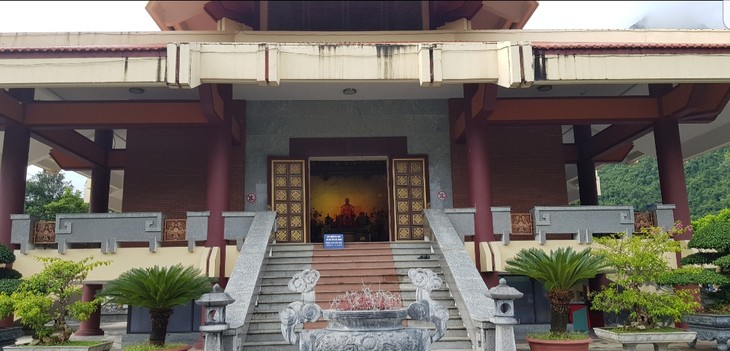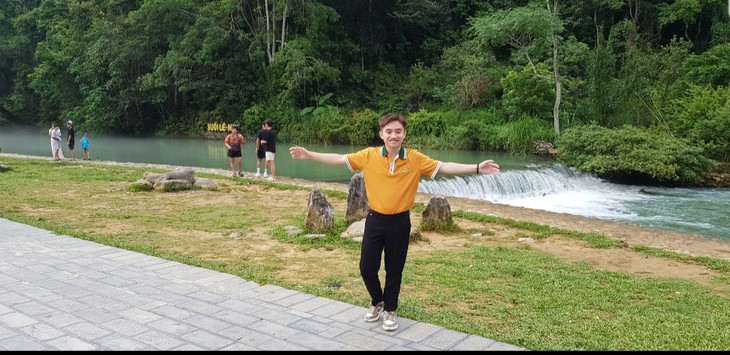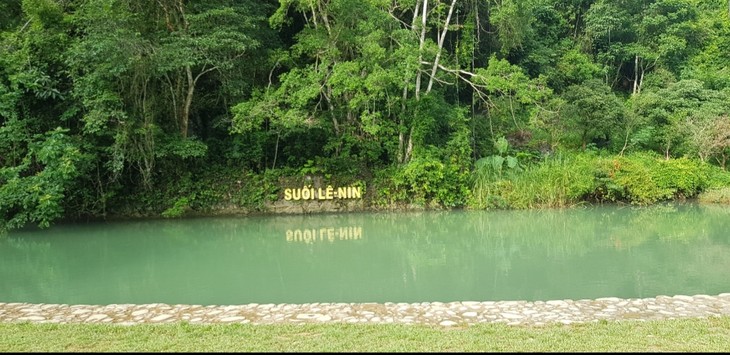(VOVWORLD) - Pac Bo relic site, the starting point (km 0) of the Ho Chi Minh trans-national road, is located in Pac Bo village, Ha Quang district, Cao Bang province. It was recognized as a Special National Relic Site by the Prime Minister in 2012.
 President Ho Chi Minh Temple at Pac Bo relic site (Photo: Ngoc Anh) President Ho Chi Minh Temple at Pac Bo relic site (Photo: Ngoc Anh) |
After 30 years of traveling abroad for national salvation, in 1941, Ho Chi Minh returned to Vietnam across the border marker 108 in Pac Bo, from where he directly led the Vietnamese revolution. Pac Bo is closely associated with this historic period of the Vietnamese revolution and President Ho Chi Minh from 1941 to 1945.
Pac Bo Special National Relic Site amazes visitors for its waterfalls, crystal-clear water springs, vast primitive forests, challenging rocky mountains, and fertile rice fields. The relic site houses a temple dedicated to President Ho Chi Minh, Coc Bo, Lung Ngan, and Nguom Vai caves on the Karl Marx mountain, Lenin stream, Khuoi Nam and Kim Dong attraction, and the house of Duong Van Dinh.
Lenin stream used to be called Khuoi Giang by the locals, which means the Heaven Spring in the Tay language. In 1941, when Ho Chi Minh returned to Vietnam and stayed in Pac Bo cave, he renamed it Lenin stream.
The first stop at Pac Po relic site is President Ho Chi Minh Temple. It was inaugurated on May 19, 2011 to mark the 121st birthday of President Ho Chi Minh.
 Tourists take photos at Lenin stream. (Photo: Ngoc Anh) Tourists take photos at Lenin stream. (Photo: Ngoc Anh) |
Doan Mai Hien, a Tay tourist guide, said: “President Ho Chi Minh’s Temple resembles the stilt house of the Tay and Nung ethnic groups. It’s plain and modest, but is iconic. A horizontal lacquered board and two parallel sentences compiled by Professor, Labour Hero Vu Khieu, are seen clearly. Words on the horizontal lacquered board compare President Ho Chi Minh as red, bright sunshine guiding the Vietnamese revolution. At the center is the statue of President Ho Chi Minh. The copper statue is 1.8 m high and weighs 1.26 tons.”
When he first returned to Vietnam, Ho Chi Minh lived and worked in Pac Bo cave, which is about 15 s.q meter. In the cave, there remains a wooden board on which he slept, a fireplace to keep him warm, and a stone table where he worked. By the Lenin stream, there is a rock where he often sat to fish. He also tended a bamboo garden next to the cave.
Khuoi Nam shack, which is about 1 km from Pac Bo cave, is another shelter where President Ho Chi Minh stayed for the lengthiest time in Pac Bo. It was built in the stilt-house style, which was discreet and convenient for observation from inside and for retreat if enemies approached. Close to Pac Po cave are Slí Dieng and Diem Tieu caves, which were used as secret mailboxes.
 Lenin stream at Pac Bo Special National Relic Site (Photo: Ngoc Anh) Lenin stream at Pac Bo Special National Relic Site (Photo: Ngoc Anh) |
After visiting the Pac Bo Special National Relic Site, tourist Do Trong Dong said: “Lenin stream, Karl Marx mountain, and Pac Bo cave are beautiful. These historical venues are associated with President Ho Chi Minh's revolutionary activities. When I come here, I feel a strong emotion in my heart about revolutionary education. This is a red revolutionary address, where President Ho Chi Minh returned to work after more than 30 years of traveling overseas to seek way to save the nation. I've been here many times, and each time I have a sacred feeling.”
The Kim Dong relic cluster is an important part of the Pac Bo Special National Relic Site. There is the tomb of Kim Dong at the foot of Teo Lai mountain in Na village. Kim Dong, a Tay ethnic young boy, whose real name was Nong Van Den, was a messenger to receive Viet Minh visitors and deliver letters. He died while on duty on February 15, 1943 when he was only 14 years old.
At Pac Po, the house of villager Duong Van Dinh is where Ho Chi Minh often came to talk with the locals, whose country was under colonial rule, about their sufferings and teach about the revolution.
Pac Bo Special National Relic is an attractive destination for its superb natural landscapes as well as historical sites associated with President Ho Chi Minh’s revolutionary life and the Party Central Committee from 1941 to 1945.